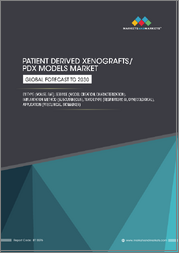
|
시장보고서
상품코드
1691788
간모세포종 치료 시장 - 세계 산업 규모, 점유율, 동향, 기회, 예측, 약제 클래스별, 치료별, 최종사용자별, 지역별 부문, 경쟁(2020-2030년)Hepatoblastoma Treatment Market - Global Industry Size, Share, Trends, Opportunity, and Forecast, Segmented By Drug Class, By Treatment, By End User By Region & Competition, 2020-2030F |
||||||
간모세포종 치료 세계 시장은 2024년 3억 5,467만 달러에 달했고, 예측 기간 동안 7.62%의 연평균 복합 성장률(CAGR)로 2030년까지 강력한 성장이 예상됩니다.
간모세포종 치료제 세계 시장은 희귀한 소아 간암인 간모세포종의 유병률 증가를 반영하여 최근 몇 년동안 괄목할 만한 성장과 진화를 거듭하고 있습니다. 간모세포종은 주로 영유아에게 발생하기 때문에 의료 서비스 제공업체 및 제약사에게 중요한 관심사가 되고 있습니다. 이 시장에는 수술, 화학요법, 표적치료 등 다양한 치료법이 포함되며, 모두 환자의 예후와 삶의 질을 개선하는 것을 목표로 하고 있습니다. 예를 들어, 2024년에 발표된 논문에 따르면, 간암의 멀티오믹스 분석에 따르면 단백질 키나아제 A 경로의 다양한 장애가 섬유성 간세포암의 발병에 총체적으로 기여한다는 사실이 밝혀졌습니다.
| 시장 개요 | |
|---|---|
| 예측 기간 | 2026-2030년 |
| 시장 규모 : 2024년 | 3억 5,467만 달러 |
| 시장 규모 : 2030년 | 5억 4,665만 달러 |
| CAGR : 2025-2030년 | 7.62% |
| 급성장 부문 | 외과 수술 |
| 최대 시장 | 북미 |
시장 성장 촉진요인
간 모세포종 발생률 증가
주요 시장 이슈
인지력 저하와 조기 진단
주요 시장 동향
정밀의료의 발전
목차
제1장 개요
제2장 조사 방법
제3장 주요 요약
제4장 세계의 간모세포종 치료 시장 전망
- 시장 규모와 예측
- 금액별
- 시장 점유율과 예측
- 약제 클래스별(알킬화제, 항생제, 빈카 알칼로이드, 항대사제, 기타)
- 치료별(수술, 화학요법, 표적치료, 방사선요법, 절제요법, 기타)
- 최종사용자별(병원 및 진료소, 외래 진료 센터, 기타)
- 지역별
- 기업별(2024년)
- 시장 맵
- 약제 클래스별
- 치료별
- 최종사용자별
- 지역별
제5장 아시아태평양의 간모세포종 치료 시장 전망
- 시장 규모와 예측
- 금액별
- 시장 점유율과 예측
- 약제 클래스별
- 치료별
- 최종사용자별
- 국가별
- 아시아태평양 : 국가별 분석
- 중국
- 인도
- 호주
- 일본
- 한국
제6장 유럽의 간모세포종 치료 시장 전망
- 시장 규모와 예측
- 시장 점유율과 예측
- 유럽 : 국가별 분석
- 독일
- 스페인
- 이탈리아
- 영국
제7장 북미의 간모세포종 치료 시장 전망
- 시장 규모와 예측
- 시장 점유율과 예측
- 북미 : 국가별 분석
- 멕시코
- 캐나다
제8장 남미의 간모세포종 치료 시장 전망
- 시장 규모와 예측
- 시장 점유율과 예측
- 남미 : 국가별 분석
- 아르헨티나
- 콜롬비아
제9장 중동 및 아프리카의 간모세포종 치료 시장 전망
- 시장 규모와 예측
- 시장 점유율과 예측
- 중동 및 아프리카 : 국가별 분석
- 사우디아라비아
- 아랍에미리트(UAE)
- 이집트
제10장 시장 역학
- 성장 촉진요인
- 과제
제11장 시장 동향과 발전
- 최근 동향
- 제품 출시
- 인수합병(M&A)
제12장 세계의 간모세포종 치료 시장 : SWOT 분석
제13장 Porter의 Five Forces 분석
- 업계내 경쟁
- 신규 참여 가능성
- 공급업체의 힘
- 고객의 힘
- 대체품의 위협
제14장 경쟁 구도
- Eureka Therapeutics.
- Fennec Pharmaceuticals Inc.
- Eli Lilly and Company
- Bristol-Myers Squibb Company
- Cipla Limited
- Pfizer Inc.
- AstraZeneca Plc
- Boston Scientific Corporation
- Nantong Haier's Pharmaceutical co. ltd
- GSK plc
제15장 전략적 제안
제16장 리서치사에 대해 & 면책사항
LSH 25.04.15Global Hepatoblastoma Treatment Market was valued at USD 354.67 million in 2024 and is anticipated to project robust growth in the forecast period with a CAGR of 7.62% through 2030. The Global Hepatoblastoma Treatment Market has witnessed significant growth and evolution in recent years, reflecting the increasing prevalence of hepatoblastoma, a rare pediatric liver cancer. Hepatoblastoma primarily affects infants and young children, making it a critical concern for healthcare providers and pharmaceutical companies alike. This market encompasses a wide range of treatment modalities, including surgery, chemotherapy, and targeted therapies, all aimed at improving the prognosis and quality of life for affected patients. For instance, according to a 2024 published article, liver cancer multiomics analysis reveals that various disruptions in protein kinase A pathways collectively contribute to the development of fibrolamellar hepatocellular carcinoma.
| Market Overview | |
|---|---|
| Forecast Period | 2026-2030 |
| Market Size 2024 | USD 354.67 Million |
| Market Size 2030 | USD 546.65 Million |
| CAGR 2025-2030 | 7.62% |
| Fastest Growing Segment | Surgery |
| Largest Market | North America |
Key Market Drivers
Increasing Incidence of Hepatoblastoma
The increasing incidence of hepatoblastoma has emerged as a pivotal driver propelling the growth of the Global Hepatoblastoma Treatment Market. For instance, a 2024 article published in Frontiers explores cancer immunogenic cell death through pyroptosis using CXCR4-targeted nanotoxins in hepatocellular carcinoma. This study highlights how nanotoxins specifically targeting CXCR4 can induce pyroptosis, a form of programmed cell death, enhancing anti-tumor immunity. These findings offer promising advancements in immunotherapy strategies for hepatocellular carcinoma treatment. Hepatoblastoma, a rare pediatric liver cancer, has seen a notable uptick in diagnosed cases in recent years. This rise in prevalence, particularly among infants and young children, has spurred a growing demand for innovative and effective treatment solutions. While hepatoblastoma remains relatively uncommon, the steady increase in its incidence has intensified efforts within the medical community and the pharmaceutical industry to address the disease comprehensively.
The surge in hepatoblastoma cases underscores the urgency of developing advanced treatment modalities to combat this challenging cancer effectively. Early diagnosis and intervention are critical in hepatoblastoma cases, and the escalating number of patients diagnosed underscores the pressing need for treatment options that can provide favorable outcomes. This growing incidence has not only heightened awareness about the disease but has also encouraged healthcare providers and researchers to explore novel therapeutic approaches.
The increasing incidence of hepatoblastoma has galvanized funding and support from governments, research institutions, and nonprofit organizations. This financial backing has spurred research and development activities, leading to the discovery of more targeted and efficacious treatment strategies. As the medical community continues to unravel the complexities of hepatoblastoma and its underlying causes, innovative treatments are emerging, offering renewed hope to patients and their
Key Market Challenges
Limited Awareness and Early Diagnosis
Hepatoblastoma, a rare form of liver cancer that predominantly affects young children, presents a unique challenge to the global healthcare community. While advances in medical science have improved treatment options and survival rates, the battle against hepatoblastoma faces a significant obstacle: limited awareness and early diagnosis. Hepatoblastoma is often described as a silent threat due to its relatively low incidence rate and nonspecific symptoms in its early stages. Children affected by this cancer may experience abdominal pain, weight loss, or a lump in the abdomen, which can be easily overlooked or misattributed to less severe conditions. Consequently, diagnosis often occurs at later, more advanced stages of the disease, making treatment more challenging and less effective.
The delayed diagnosis of hepatoblastoma has profound consequences. At advanced stages, the cancer may have already spread to other parts of the liver or distant organs, reducing the likelihood of a complete cure. Timely intervention is critical to improving survival rates and minimizing the intensity of treatment required. Unfortunately, limited awareness among parents, caregivers, and healthcare providers often leads to a protracted diagnostic journey.
Key Market Trends
Advances in Precision Medicine
Advances in precision medicine have emerged as a groundbreaking trend that is significantly boosting the global hepatoblastoma treatment market. Precision medicine, also known as personalized medicine, is a revolutionary approach that tailors treatment strategies to the specific genetic and molecular characteristics of individual patients. In the context of hepatoblastoma, this approach has ushered in a new era of hope and improved outcomes for young patients facing this rare liver cancer.
One of the key breakthroughs in precision medicine for hepatoblastoma is the identification of specific genetic mutations and markers associated with the disease. Researchers have delved deep into the molecular biology of hepatoblastoma, uncovering critical insights into the mechanisms driving its growth and progression. This newfound knowledge has paved the way for the development of targeted therapies that precisely address these specific molecular aberrations. These targeted therapies are designed to disrupt the signaling pathways or cellular processes that promote hepatoblastoma growth while sparing healthy tissues from harm. Unlike traditional chemotherapy, which can cause systemic side effects, these precision medications are more selective, leading to improved treatment effectiveness and a reduction in adverse events.
Key Market Players
- Eureka Therapeutics.
- Fennec Pharmaceuticals Inc.
- Eli Lilly and Company
- Bristol-Myers Squibb Company
- Cipla Limited
- Pfizer Inc.
- AstraZeneca Plc
- Boston Scientific Corporation
- Nantong Haier's Pharmaceutical co. ltd
- GSK plc
Report Scope:
In this report, the Global Hepatoblastoma Treatment Market has been segmented into the following categories, in addition to the industry trends which have also been detailed below:
Hepatoblastoma Treatment Market, By Drug Class:
- Alkylating Agent
- Antibiotics
- Vinca Alkaloids
- Antimetabolites
- Others
- Hepatoblastoma Treatment Market, By Treatment
- Surgery
- Chemotherapy
- Targeted Therapy
- Radiation Therapy
- Ablation Therapy
- Others
- Hepatoblastoma Treatment Market, By End User
- Hospitals & Clinics
- Ambulatory care Centers
- Others
Hepatoblastoma Treatment Market, By Region:
- North America
- United States
- Canada
- Mexico
- Europe
- France
- United Kingdom
- Italy
- Germany
- Spain
- Asia-Pacific
- China
- India
- Japan
- Australia
- South Korea
- South America
- Brazil
- Argentina
- Colombia
- Middle East & Africa
- South Africa
- Saudi Arabia
- UAE
- Egypt
Competitive Landscape
Company Profiles: Detailed analysis of the major companies present in the Global Hepatoblastoma Treatment Market.
Available Customizations:
Global Hepatoblastoma Treatment Market report with the given market data, TechSci Research offers customizations according to a company's specific needs. The following customization options are available for the report:
Company Information
- Detailed analysis and profiling of additional market players (up to five).
Table of Contents
1. Product Overview
- 1.1. Market Definition
- 1.2. Scope of the Market
- 1.2.1. Markets Covered
- 1.2.2. Years Considered for Study
- 1.2.3. Key Market Segmentations
2. Research Methodology
- 2.1. Objective of the Study
- 2.2. Baseline Methodology
- 2.3. Key Industry Partners
- 2.4. Major Association and Secondary Sources
- 2.5. Forecasting Methodology
- 2.6. Data Triangulation & Validation
- 2.7. Assumptions and Limitations
3. Executive Summary
- 3.1. Overview of the Market
- 3.2. Overview of Key Market Segmentations
- 3.3. Overview of Key Market Players
- 3.4. Overview of Key Regions/Countries
- 3.5. Overview of Market Drivers, Challenges, Trends
4. Global Hepatoblastoma Treatment Market Outlook
- 4.1. Market Size & Forecast
- 4.1.1. By Value
- 4.2. Market Share & Forecast
- 4.2.1. By Drug Class (Alkylating Agent, Antibiotics, Vinca Alkaloids, Antimetabolites, Others)
- 4.2.2. By Treatment (Surgery, Chemotherapy, Targeted Therapy, Radiation Therapy, Ablation Therapy, Others)
- 4.2.3. By End User (Hospitals & Clinics, Ambulatory care Centers, Others)
- 4.2.4. By Region
- 4.2.5. By Company (2024)
- 4.3. Market Map
- 4.3.1. By Drug Class
- 4.3.2. By Treatment
- 4.3.3. By End User
- 4.3.4. By Region
5. Asia Pacific Hepatoblastoma Treatment Market Outlook
- 5.1. Market Size & Forecast
- 5.1.1. By Value
- 5.2. Market Share & Forecast
- 5.2.1. By Drug Class
- 5.2.2. By Treatment
- 5.2.3. By End User
- 5.2.4. By Country
- 5.3. Asia Pacific: Country Analysis
- 5.3.1. China Hepatoblastoma Treatment Market Outlook
- 5.3.1.1. Market Size & Forecast
- 5.3.1.1.1. By Value
- 5.3.1.2. Market Share & Forecast
- 5.3.1.2.1. By Drug Class
- 5.3.1.2.2. By Treatment
- 5.3.1.2.3. By End User
- 5.3.1.1. Market Size & Forecast
- 5.3.2. India Hepatoblastoma Treatment Market Outlook
- 5.3.2.1. Market Size & Forecast
- 5.3.2.1.1. By Value
- 5.3.2.2. Market Share & Forecast
- 5.3.2.2.1. By Drug Class
- 5.3.2.2.2. By Treatment
- 5.3.2.2.3. By End User
- 5.3.2.1. Market Size & Forecast
- 5.3.3. Australia Hepatoblastoma Treatment Market Outlook
- 5.3.3.1. Market Size & Forecast
- 5.3.3.1.1. By Value
- 5.3.3.2. Market Share & Forecast
- 5.3.3.2.1. By Drug Class
- 5.3.3.2.2. By Treatment
- 5.3.3.2.3. By End User
- 5.3.3.1. Market Size & Forecast
- 5.3.4. Japan Hepatoblastoma Treatment Market Outlook
- 5.3.4.1. Market Size & Forecast
- 5.3.4.1.1. By Value
- 5.3.4.2. Market Share & Forecast
- 5.3.4.2.1. By Drug Class
- 5.3.4.2.2. By Treatment
- 5.3.4.2.3. By End User
- 5.3.4.1. Market Size & Forecast
- 5.3.5. South Korea Hepatoblastoma Treatment Market Outlook
- 5.3.5.1. Market Size & Forecast
- 5.3.5.1.1. By Value
- 5.3.5.2. Market Share & Forecast
- 5.3.5.2.1. By Drug Class
- 5.3.5.2.2. By Treatment
- 5.3.5.2.3. By End User
- 5.3.5.1. Market Size & Forecast
- 5.3.1. China Hepatoblastoma Treatment Market Outlook
6. Europe Hepatoblastoma Treatment Market Outlook
- 6.1. Market Size & Forecast
- 6.1.1. By Value
- 6.2. Market Share & Forecast
- 6.2.1. By Drug Class
- 6.2.2. By Treatment
- 6.2.3. By End User
- 6.2.4. By Country
- 6.3. Europe: Country Analysis
- 6.3.1. France Hepatoblastoma Treatment Market Outlook
- 6.3.1.1. Market Size & Forecast
- 6.3.1.1.1. By Value
- 6.3.1.2. Market Share & Forecast
- 6.3.1.2.1. By Drug Class
- 6.3.1.2.2. By Treatment
- 6.3.1.2.3. By End User
- 6.3.1.1. Market Size & Forecast
- 6.3.2. Germany Hepatoblastoma Treatment Market Outlook
- 6.3.2.1. Market Size & Forecast
- 6.3.2.1.1. By Value
- 6.3.2.2. Market Share & Forecast
- 6.3.2.2.1. By Drug Class
- 6.3.2.2.2. By Treatment
- 6.3.2.2.3. By End User
- 6.3.2.1. Market Size & Forecast
- 6.3.3. Spain Hepatoblastoma Treatment Market Outlook
- 6.3.3.1. Market Size & Forecast
- 6.3.3.1.1. By Value
- 6.3.3.2. Market Share & Forecast
- 6.3.3.2.1. By Drug Class
- 6.3.3.2.2. By Treatment
- 6.3.3.2.3. By End User
- 6.3.3.1. Market Size & Forecast
- 6.3.4. Italy Hepatoblastoma Treatment Market Outlook
- 6.3.4.1. Market Size & Forecast
- 6.3.4.1.1. By Value
- 6.3.4.2. Market Share & Forecast
- 6.3.4.2.1. By Drug Class
- 6.3.4.2.2. By Treatment
- 6.3.4.2.3. By End User
- 6.3.4.1. Market Size & Forecast
- 6.3.5. United Kingdom Hepatoblastoma Treatment Market Outlook
- 6.3.5.1. Market Size & Forecast
- 6.3.5.1.1. By Value
- 6.3.5.2. Market Share & Forecast
- 6.3.5.2.1. By Drug Class
- 6.3.5.2.2. By Treatment
- 6.3.5.2.3. By End User
- 6.3.5.1. Market Size & Forecast
- 6.3.1. France Hepatoblastoma Treatment Market Outlook
7. North America Hepatoblastoma Treatment Market Outlook
- 7.1. Market Size & Forecast
- 7.1.1. By Value
- 7.2. Market Share & Forecast
- 7.2.1. By Drug Class
- 7.2.2. By Treatment
- 7.2.3. By End User
- 7.2.4. By Country
- 7.3. North America: Country Analysis
- 7.3.1. United States Hepatoblastoma Treatment Market Outlook
- 7.3.1.1. Market Size & Forecast
- 7.3.1.1.1. By Value
- 7.3.1.2. Market Share & Forecast
- 7.3.1.2.1. By Drug Class
- 7.3.1.2.2. By Treatment
- 7.3.1.2.3. By End User
- 7.3.1.1. Market Size & Forecast
- 7.3.2. Mexico Hepatoblastoma Treatment Market Outlook
- 7.3.2.1. Market Size & Forecast
- 7.3.2.1.1. By Value
- 7.3.2.2. Market Share & Forecast
- 7.3.2.2.1. By Drug Class
- 7.3.2.2.2. By Treatment
- 7.3.2.2.3. By End User
- 7.3.2.1. Market Size & Forecast
- 7.3.3. Canada Hepatoblastoma Treatment Market Outlook
- 7.3.3.1. Market Size & Forecast
- 7.3.3.1.1. By Value
- 7.3.3.2. Market Share & Forecast
- 7.3.3.2.1. By Drug Class
- 7.3.3.2.2. By Treatment
- 7.3.3.2.3. By End User
- 7.3.3.1. Market Size & Forecast
- 7.3.1. United States Hepatoblastoma Treatment Market Outlook
8. South America Hepatoblastoma Treatment Market Outlook
- 8.1. Market Size & Forecast
- 8.1.1. By Value
- 8.2. Market Share & Forecast
- 8.2.1. By Drug Class
- 8.2.2. By Treatment
- 8.2.3. By End User
- 8.2.4. By Country
- 8.3. South America: Country Analysis
- 8.3.1. Brazil Hepatoblastoma Treatment Market Outlook
- 8.3.1.1. Market Size & Forecast
- 8.3.1.1.1. By Value
- 8.3.1.2. Market Share & Forecast
- 8.3.1.2.1. By Drug Class
- 8.3.1.2.2. By Treatment
- 8.3.1.2.3. By End User
- 8.3.1.1. Market Size & Forecast
- 8.3.2. Argentina Hepatoblastoma Treatment Market Outlook
- 8.3.2.1. Market Size & Forecast
- 8.3.2.1.1. By Value
- 8.3.2.2. Market Share & Forecast
- 8.3.2.2.1. By Drug Class
- 8.3.2.2.2. By Treatment
- 8.3.2.2.3. By End User
- 8.3.2.1. Market Size & Forecast
- 8.3.3. Colombia Hepatoblastoma Treatment Market Outlook
- 8.3.3.1. Market Size & Forecast
- 8.3.3.1.1. By Value
- 8.3.3.2. Market Share & Forecast
- 8.3.3.2.1. By Drug Class
- 8.3.3.2.2. By Treatment
- 8.3.3.2.3. By End User
- 8.3.3.1. Market Size & Forecast
- 8.3.1. Brazil Hepatoblastoma Treatment Market Outlook
9. Middle East and Africa Hepatoblastoma Treatment Market Outlook
- 9.1. Market Size & Forecast
- 9.1.1. By Value
- 9.2. Market Share & Forecast
- 9.2.1. By Drug Class
- 9.2.2. By Treatment
- 9.2.3. By End User
- 9.2.4. By Country
- 9.3. MEA: Country Analysis
- 9.3.1. South Africa Hepatoblastoma Treatment Market Outlook
- 9.3.1.1. Market Size & Forecast
- 9.3.1.1.1. By Value
- 9.3.1.2. Market Share & Forecast
- 9.3.1.2.1. By Drug Class
- 9.3.1.2.2. By Treatment
- 9.3.1.2.3. By End User
- 9.3.1.1. Market Size & Forecast
- 9.3.2. Saudi Arabia Hepatoblastoma Treatment Market Outlook
- 9.3.2.1. Market Size & Forecast
- 9.3.2.1.1. By Value
- 9.3.2.2. Market Share & Forecast
- 9.3.2.2.1. By Drug Class
- 9.3.2.2.2. By Treatment
- 9.3.2.2.3. By End User
- 9.3.2.1. Market Size & Forecast
- 9.3.3. UAE Hepatoblastoma Treatment Market Outlook
- 9.3.3.1. Market Size & Forecast
- 9.3.3.1.1. By Value
- 9.3.3.2. Market Share & Forecast
- 9.3.3.2.1. By Drug Class
- 9.3.3.2.2. By Treatment
- 9.3.3.2.3. By End User
- 9.3.3.1. Market Size & Forecast
- 9.3.4. Egypt Hepatoblastoma Treatment Market Outlook
- 9.3.4.1. Market Size & Forecast
- 9.3.4.1.1. By Value
- 9.3.4.2. Market Share & Forecast
- 9.3.4.2.1. By Drug Class
- 9.3.4.2.2. By Treatment
- 9.3.4.2.3. By End User
- 9.3.4.1. Market Size & Forecast
- 9.3.1. South Africa Hepatoblastoma Treatment Market Outlook
10. Market Dynamics
- 10.1. Drivers
- 10.2. Challenges
11. Market Trends & Developments
- 11.1. Recent Developments
- 11.2. Product Launches
- 11.3. Mergers & Acquisitions
12. Global Hepatoblastoma Treatment Market: SWOT Analysis
13. Porter's Five Forces Analysis
- 13.1. Competition in the Industry
- 13.2. Potential of New Entrants
- 13.3. Power of Suppliers
- 13.4. Power of Customers
- 13.5. Threat of Substitute Product
14. Competitive Landscape
- 14.1. Eureka Therapeutics.
- 14.1.1. Business Overview
- 14.1.2. Company Snapshot
- 14.1.3. Products & Services
- 14.1.4. Financials (In case of listed)
- 14.1.5. Recent Developments
- 14.1.6. SWOT Analysis
- 14.2. Fennec Pharmaceuticals Inc.
- 14.3. Eli Lilly and Company
- 14.4. Bristol-Myers Squibb Company
- 14.5. Cipla Limited
- 14.6. Pfizer Inc.
- 14.7. AstraZeneca Plc
- 14.8. Boston Scientific Corporation
- 14.9. Nantong Haier's Pharmaceutical co. ltd
- 14.10. GSK plc
15. Strategic Recommendations
16. About Us & Disclaimer
(주말 및 공휴일 제외)


















